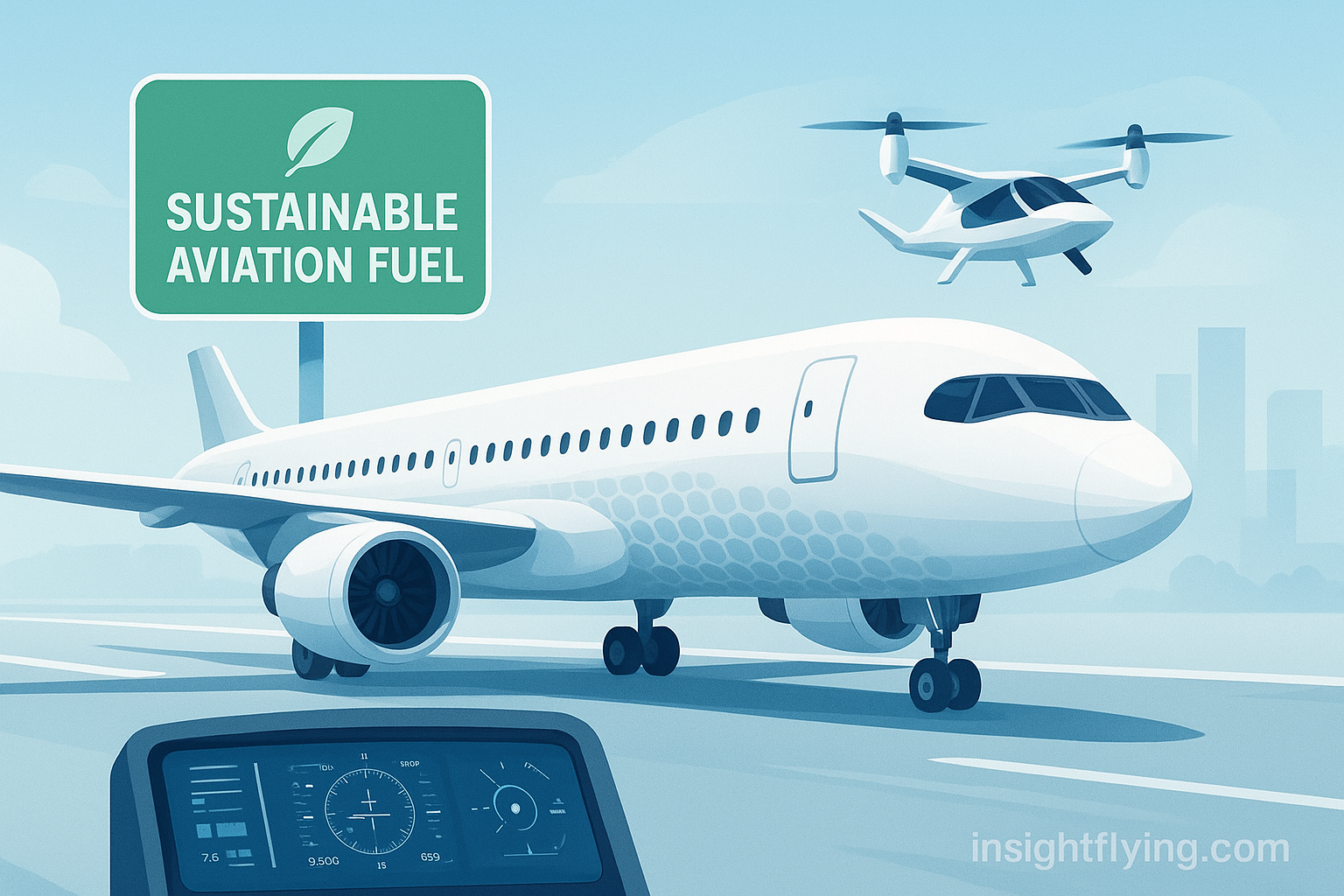เทคโนโลยีใหม่ในอากาศยาน
บทนำ
การบินถือเป็นอุตสาหกรรมที่ผสมผสานระหว่างศาสตร์และศิลป์ของวิศวกรรม เทคโนโลยี และการจัดการอย่างซับซ้อน ตลอดกว่าศตวรรษที่ผ่านมา เทคโนโลยีการบินได้ก้าวหน้าอย่างไม่หยุดยั้ง จากยุคเครื่องบินไม้ผ้าใบ มาสู่เครื่องบินเจ็ตความเร็วสูง และในปัจจุบันกำลังเข้าสู่ยุคของความยั่งยืนและระบบดิจิทัล เทคโนโลยีใหม่ไม่เพียงแต่ทำให้การเดินทางปลอดภัยและสะดวกสบายขึ้น แต่ยังตอบโจทย์ความท้าทายด้านสิ่งแวดล้อมและต้นทุนการดำเนินงานที่สายการบินทั่วโลกต้องเผชิญ
เทคโนโลยีสำคัญที่น่าจับตามอง
1. Sustainable Aviation Fuel (SAF)
เชื้อเพลิงการบินที่ผลิตจากแหล่งพลังงานทดแทน เช่น พืชพลังงาน ของเสียอินทรีย์ หรือแม้กระทั่งน้ำมันใช้แล้ว SAF สามารถลดการปล่อยก๊าซเรือนกระจกได้ถึง 80% เมื่อเทียบกับ Jet A-1 เชื้อเพลิงแบบดั้งเดิม ปัจจุบันสายการบินใหญ่ ๆ เริ่มทยอยนำมาใช้มากขึ้น
2. More Electric Aircraft (MEA)
แนวคิดการแทนที่ระบบไฮดรอลิกและนิวเมติกด้วยระบบไฟฟ้า เช่น ปั๊มไฮดรอลิกไฟฟ้า ระบบเบรกไฟฟ้า หรือแม้กระทั่งเครื่องยนต์เสริมพลังงานไฟฟ้า (Electric Taxiing) สิ่งนี้ช่วยลดน้ำหนัก ลดการซ่อมบำรุง และเพิ่มประสิทธิภาพการใช้พลังงาน
3. Composite Materials
โครงสร้างเครื่องบินยุคใหม่ เช่น Boeing 787 และ Airbus A350 ใช้วัสดุคอมโพสิตอย่าง Carbon Fiber Reinforced Polymer (CFRP) มากกว่า 50% ของน้ำหนักลำตัว ซึ่งมีคุณสมบัติเบา แข็งแรง และทนทานต่อการกัดกร่อน ทำให้ประหยัดเชื้อเพลิงและยืดอายุการใช้งาน
4. Next-Generation Avionics
ระบบ Avionics ยุคใหม่ผสานปัญญาประดิษฐ์ (AI), Big Data และระบบคาดการณ์ล่วงหน้า (Predictive Maintenance) นักบินสามารถเข้าถึงข้อมูลที่แม่นยำแบบเรียลไทม์ สนับสนุนการตัดสินใจ และช่วยให้การบำรุงรักษาเครื่องบินทำได้รวดเร็วและตรงจุด
5. Digital Twin
เทคโนโลยีที่สร้างแบบจำลองเสมือนจริงของเครื่องบินหรือเครื่องยนต์ ใช้สำหรับทดสอบ วิเคราะห์ และคาดการณ์พฤติกรรมของชิ้นส่วนต่าง ๆ โดยไม่จำเป็นต้องทดสอบจริง ช่วยลดค่าใช้จ่ายและเวลาการพัฒนาอย่างมาก
6. Single Pilot Operation & Advanced Cockpit Automation
มีการพัฒนาระบบที่ช่วยให้นักบินสามารถปฏิบัติการบินได้ด้วยนักบินเพียงคนเดียวในบางเที่ยวบิน โดยใช้ระบบอัตโนมัติขั้นสูงและ AI อย่างไรก็ตาม ยังเป็นประเด็นถกเถียงเรื่องความปลอดภัยและการยอมรับจากหน่วยงานกำกับดูแล
7. Urban Air Mobility (UAM)
การขนส่งรูปแบบใหม่ด้วยเครื่องบินไฟฟ้าขนาดเล็กที่สามารถขึ้นลงแนวตั้ง (eVTOL) ซึ่งถูกมองว่าอาจเป็นอนาคตของการเดินทางระยะสั้นในเมืองใหญ่ ช่วยลดเวลาเดินทางและแก้ปัญหาการจราจร
ผลกระทบต่ออุตสาหกรรมการบิน
- ประหยัดต้นทุน: เชื้อเพลิงและการบำรุงรักษามีประสิทธิภาพมากขึ้น
- เป็นมิตรต่อสิ่งแวดล้อม: ลดการปล่อยก๊าซเรือนกระจกและเสียงรบกวน
- เพิ่มความปลอดภัย: ระบบคาดการณ์ล่วงหน้าและ AI ช่วยลดโอกาสเกิดข้อผิดพลาด
- เปลี่ยนแปลงบทบาทบุคลากร: นักบิน วิศวกร และพนักงานอำนวยการบินต้องพัฒนาทักษะใหม่ให้สอดคล้องกับเทคโนโลยี
ความท้าทาย
แม้เทคโนโลยีใหม่จะมีศักยภาพสูง แต่ก็เผชิญความท้าทายหลายด้าน เช่น
- กฎระเบียบและการรับรองความปลอดภัยจากหน่วยงานการบินพลเรือน
- เงินลงทุนในการวิจัยและพัฒนาที่สูง
- การยอมรับจากผู้โดยสารและสังคม
สรุป
เทคโนโลยีใหม่ในอากาศยานคือแรงขับเคลื่อนสำคัญของการพัฒนาอุตสาหกรรมการบินในศตวรรษที่ 21 เครื่องบินในอนาคตไม่เพียงแต่ต้องเร็วและปลอดภัย แต่ยังต้องเป็นมิตรต่อสิ่งแวดล้อม และมีระบบอัจฉริยะที่สนับสนุนมนุษย์ เทคโนโลยีเหล่านี้กำลังค่อย ๆ เปลี่ยนโฉมหน้าของการบินให้ก้าวสู่ยุคใหม่ของ ความปลอดภัย ความยั่งยืน และประสิทธิภาพสูงสุด
Aircraft New Technology
Introduction
Aviation has always been at the forefront of human innovation, combining engineering, technology, and complex operations. Over more than a century, aircraft technology has advanced continuously — from wooden fabric airplanes to high-speed jetliners. Today, the industry is entering a new era driven by sustainability and digitalization. These emerging technologies not only make air travel safer and more comfortable but also address environmental challenges and the rising operational costs faced by airlines worldwide.
Key Emerging Technologies
1. Sustainable Aviation Fuel (SAF)
SAF is produced from renewable sources such as energy crops, organic waste, or even recycled cooking oil. It can reduce greenhouse gas emissions by up to 80% compared to traditional Jet A-1 fuel. Many major airlines are already introducing SAF into their operations.
2. More Electric Aircraft (MEA)
The MEA concept replaces hydraulic and pneumatic systems with electrical systems, such as electric hydraulic pumps, electric braking, and even electric taxiing. This reduces aircraft weight, simplifies maintenance, and improves energy efficiency.
หนังสือ A Pilot Books ในรูปแบบ eBook ที่ MebMarket
สร้างแรงบันดาลใจ…..เริ่มเมื่อไหร่

|
|

|
|

|
|

|
|

|
|
3. Composite Materials
Modern aircraft such as the Boeing 787 and Airbus A350 incorporate more than 50% composite materials, primarily Carbon Fiber Reinforced Polymer (CFRP). These materials are lightweight, durable, and resistant to corrosion, contributing to fuel savings and longer service life.
4. Next-Generation Avionics
Avionics are becoming smarter, integrating Artificial Intelligence (AI), Big Data, and Predictive Maintenance. Pilots can access real-time, accurate data to support decision-making, while airlines benefit from faster and more precise maintenance processes.
5. Digital Twin
A digital twin is a virtual model of an aircraft or engine that can simulate, analyze, and predict performance without physical testing. This technology significantly reduces development costs and time.
6. Single Pilot Operation & Advanced Cockpit Automation
New cockpit technologies aim to enable operations with a single pilot in specific flights, supported by advanced automation and AI. However, this remains controversial due to safety concerns and regulatory challenges.
7. Urban Air Mobility (UAM)
Electric Vertical Take-Off and Landing (eVTOL) aircraft represent a new form of transportation for short urban routes. UAM has the potential to reduce travel times in congested cities and create new modes of air transport.
Impacts on the Aviation Industry
- Cost Efficiency: Lower fuel burn and reduced maintenance needs.
- Environmental Benefits: Reduced emissions and noise footprint.
- Enhanced Safety: Predictive systems and AI reduce human error.
- Shifting Roles: Pilots, engineers, and dispatchers must adapt and develop new skills aligned with advanced technologies.
Challenges
Despite the promise of these technologies, several challenges remain:
- Certification and regulatory approval from civil aviation authorities.
- High research and development costs.
- Social acceptance from passengers and the public.
Conclusion
New technologies are the driving force behind aviation’s transformation in the 21st century. The aircraft of the future will not only be faster and safer but also environmentally sustainable and digitally intelligent. These innovations are reshaping aviation into a new era defined by safety, sustainability, and efficiency.

Leave a Reply
You must be logged in to post a comment.